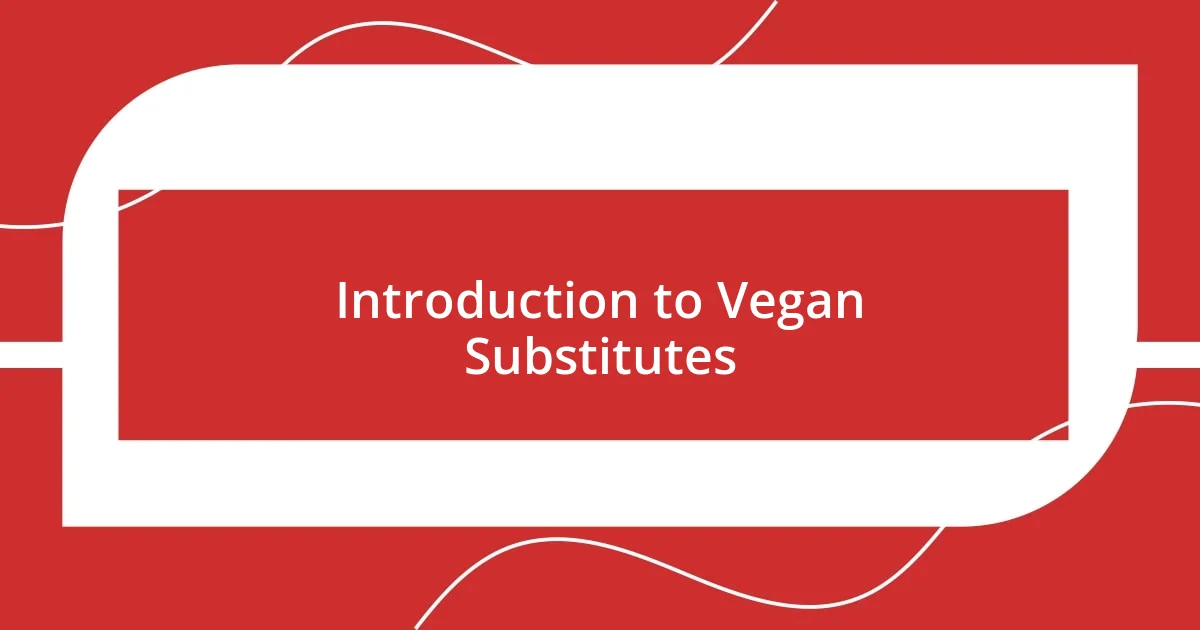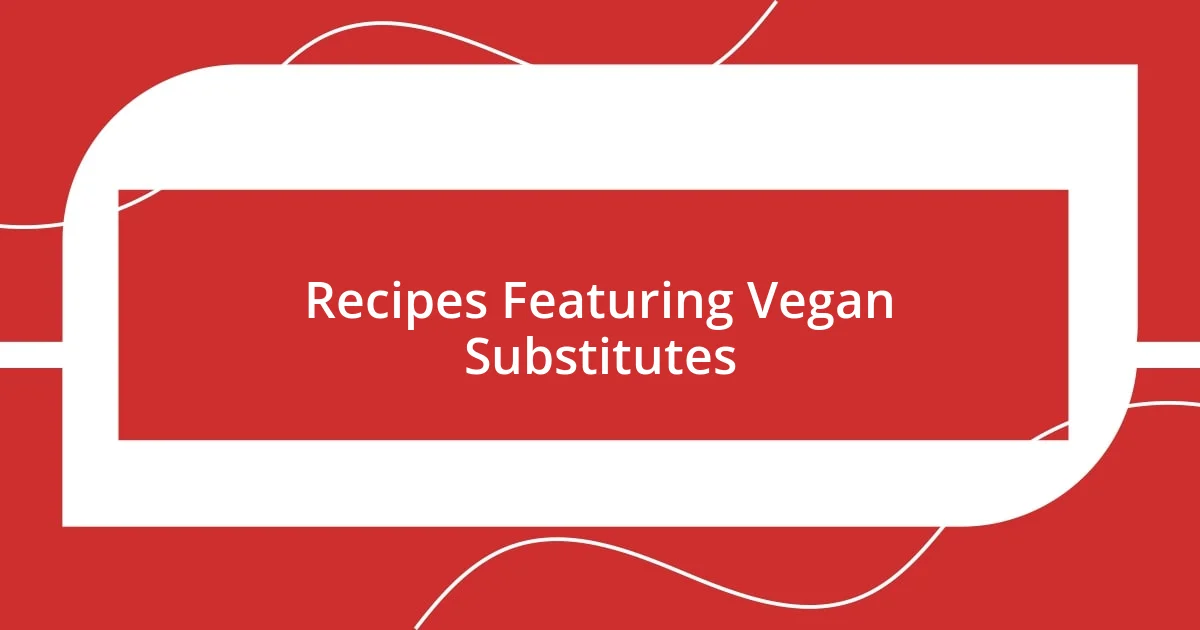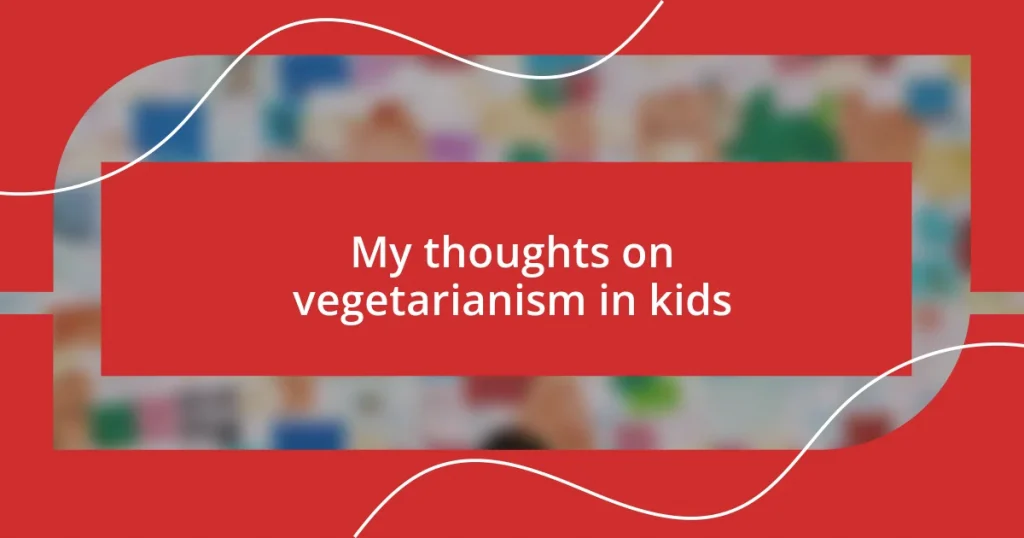Key takeaways:
- The journey to adopting vegan substitutes opens up new flavors and textures, allowing for creative and healthier meals.
- Key motivations for choosing vegan options include health benefits, ethical considerations, and sustainability, enhancing the cooking experience and personal fulfillment.
- Experimentation and patience are essential in vegan cooking to achieve the desired taste and texture, making small adjustments significantly impactful.

Introduction to Vegan Substitutes
When I first transitioned to a vegan lifestyle, I found myself confronted with an unexpected challenge: what to eat in place of my beloved animal products. It was a journey of discovery, and I quickly learned that vegan substitutes could not only mimic traditional foods but, in many cases, offer exciting new flavors and textures that I had never considered before. Have you ever wondered how a simple ingredient can completely revolutionize your meal?
As I experimented in the kitchen, it became a game of trial and error—a splash of plant-based milk here, a sprinkle of nutritional yeast there. Those early attempts at creating delicious vegan versions of my favorite comfort foods often led to delightful surprises that left me craving more. For instance, I remember my first try at making cashew cream; it was so creamy and rich that I couldn’t believe it wasn’t dairy. Isn’t it fascinating how these substitutes can sometimes even elevate a dish beyond its original glory?
Vegan substitutes are not just about replacing one ingredient with another; they’re an invitation to open up to a variety of plant-based options that nourish our bodies and the planet. I’ve come to realize that this journey is not merely a dietary change but a chance to explore new ways of eating that align with my values. What if every meal could be a celebration of both flavor and compassion? The beauty of vegan substitutes lies in their ability to turn that possibility into a delightful reality.

Reasons for Choosing Vegan Substitutes
Choosing vegan substitutes can stem from a variety of motivations. For me, one of the most significant reasons was health. I started to notice the positive changes in my energy levels and digestion after incorporating more plant-based foods. Have you ever felt a sudden boost after a nutrient-rich meal? It’s a game-changer. I was pleasantly surprised by how good I felt when I replaced rich dairy products with alternatives like almond yogurt or coconut milk.
Another reason I embraced vegan substitutes is ethical. Knowing that my food choices align with my values made a profound difference in my day-to-day experience. I recall a moment when I watched a documentary about animal farming that really struck a chord with me. It made me more conscious of the impacts of my choices, leading me to seek alternatives like lentil burgers or chickpea salads. It’s powerful to feel connected to a cause through what I eat.
Lastly, sustainability plays a crucial role in my decision to use vegan substitutes. I’ve learned about the environmental footprint of meat production, and it motivated me to explore plant-based options. Recently, while whipping up a dish with quinoa and roasted vegetables, I couldn’t help but feel a sense of pride knowing I was contributing to a healthier planet. Sharing a meal that’s not only delicious but also environmentally friendly creates a sense of purpose that’s incredibly fulfilling.
| Reason | Personal Experience |
|---|---|
| Health | Boosted energy and improved digestion after switching to plant-based foods. |
| Ethics | Feeling aligned with my values after learning about animal farming. |
| Sustainability | Choosing plant-based options contributes positively to the environment. |

Common Vegan Ingredients I Use
I’ve found that certain vegan ingredients have become staples in my kitchen, transforming the way I approach meals. These ingredients not only serve as alternatives but have also surprisingly introduced me to new flavors and textures. For instance, the first time I ever used jackfruit to create a pulled ‘pork’ sandwich, I was blown away. The meatiness of it was uncanny, and I felt like I had discovered a hidden gem in the world of plant-based cooking.
Here are some common vegan ingredients I regularly use:
- Nutritional Yeast: Adds a cheesy flavor to dishes and is packed with B vitamins.
- Chickpeas: Versatile for salads, stews, or turning into hummus for a tasty dip.
- Cashews: A base for creamy sauces and dressings when blended.
- Flaxseeds: Great for egg replacement in baking; just mix with water to create a gel.
- Coconut Milk: Rich and creamy, perfect for curries and desserts alike.
Another ingredient that has become a go-to for me is tempeh. I was curious to try it after hearing so many rave reviews, and when I marinated it in soy sauce and grilled it, I experienced a revelation. The flavor was so robust that I could hardly believe it was made from fermented soybeans. Such moments keep me excited about vegan cooking; they fill me with a sense of culinary adventure, encouraging me to keep pushing the boundaries of traditional recipes.

Cooking Tips for Vegan Substitutes
When experimenting with vegan substitutes, I’ve learned that the right seasoning can elevate a dish immensely. For example, I remember the first time I used smoked paprika on roasted chickpeas. The depth of flavor it added was simply incredible! Can you believe how something as simple as a spice can transform a straightforward ingredient into something remarkable?
Another tip I would share is to understand the texture you want in your dish. I’ve had my share of kitchen flops when I underestimated how important that would be. One time, when making a vegan lasagna, I used silken tofu instead of ricotta, thinking it would be a quick fix. It turned out too mushy! Since then, I stick to crumbled firm tofu mixed with herbs for a better consistency. It’s all about finding those little tweaks that can make a big difference.
Lastly, I can’t emphasize enough the importance of patience in the cooking process. I recall being in a hurry and skipping the marinating step for my tofu stir-fry once. The dish felt lacking, almost dull. In contrast, when I gave it the time to soak up those flavors overnight, it became a feast better than I could have hoped. Have you ever rushed a recipe and regretted it? Allowing time for flavors to meld is definitely a game-changer in vegan cooking.

Recipes Featuring Vegan Substitutes
Cooking with vegan substitutes has opened up countless doors for creativity in my kitchen. One unforgettable dish I made was vegan tacos with lentils and avocado. The first time I tried it, I marinated the lentils with cumin and lime, and the burst of flavors transported me straight to a vibrant street market. Does anyone else feel that thrill when a simple recipe elevates a regular meal into an explosion of taste?
When it comes to smoothies, using frozen bananas in place of yogurt has been a revelation for me. Blending them gives the drink such a creamy consistency that you’d hardly miss the dairy. I remember the first time I served this to a friend, completely unaware of the vegan nature of it. Watching their surprise when I told them it was plant-based was so rewarding! Who knew a humble frozen banana could be such a game changer in breakfast smoothies?
Let’s not forget about desserts; I once whipped up a chocolate mousse using silken tofu and dark chocolate. The texture was so luxuriously smooth that I honestly couldn’t get over it. You might think, “Can tofu really replace heavy cream?” Trust me, after tasting it, you’ll be convinced. Even my non-vegan friends couldn’t resist asking for seconds! The joy of turning a traditional dessert into something healthier yet equally delicious is incredibly fulfilling. Have you ever had a moment where you completely surprised yourself in the kitchen like this?

Challenges with Vegan Substitutes
Navigating vegan substitutes can sometimes feel like walking through a maze, especially when it comes to flavor balance. I remember the first time I replaced eggs with flaxseed in a baking recipe; let’s just say the results were more like a cookie pancake than the chewy treat I was aiming for. It was a lesson in understanding how different ingredients work together – have you ever felt that frustration in the kitchen?
Then there’s the challenge of finding the right substitute for cheese. Admittedly, I was skeptical about using cashew cream as a replacement for creamy sauces. The initial attempt left me feeling disappointed and a bit lost, as the texture and taste fell flat. However, with a bit of experimentation and some nutritional yeast added, I discovered a delicious alternative that can actually mimic cheese. Who would have thought these little tweaks could make such a substantial difference?
Lastly, I’ve faced the struggle of texture when it comes to vegan meats. One time, I tried making a vegan burger with lentils and oats but neglected to bind them properly. The result? A glorious disaster that crumbled apart on the grill. But that experience taught me about the importance of ratios in vegan cooking and how a little extra patience in mixing and binding can lead to the perfect patty. Have you encountered moments like this in your culinary journey?















